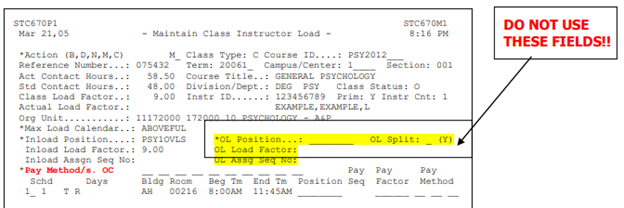Instructor Class Schedule
Using the IRM System of PantherNet to Assign Faculty to Classes
The process of assigning faculty to classes and generating assignments will be presented in two sections:
- Full-Time Instructors
- Part-Time Instructors
You must carefully select which of the following scenarios under which your instructor falls to know which set of instructions to use in this manual. After each scenario below is reviewed, the manual will review information on running final contracts, checking status of pending assignments and other IRM reports that are applicable to both full-time and part-time instructors.
Full-Time Faculty Categories
- Full-time Faculty teaching in Fall and Spring
- Full-time Faculty teaching in Summer
Part-Time Faculty Categories
- Part-time faculty who teach for Palm Beach State but are not full-time employees of Palm Beach State (part-time faculty without retirement benefits).
- Part-time faculty who teach for Palm Beach State but hold regular full-time or part-time employment at Palm Beach State in other than a faculty position OR the person has worked more 2,080 hours at Palm Beach State (part-time faculty with retirement benefits).
- Full-time non-instructional personnel (i.e., Program Specialists) and CCP Program Instructors who teach as part of their regular job duties.
Full-Time Instructors
As mentioned previously, during the Fall and Spring Term, faculty must be assigned a point load of 90 points across the contract period (Fall and Spring). Although most faculty work at least 45 points in each term, there are instances where faculty will teach 36 points in one term and 54 in the other, for a total of 90 points.
Determining Class Assignments for Fall and Spring Terms
In using the IRM system, you would follow these steps:
- Make sure faculty member is credentialed for the class
- Assign faculty member to the class
- Determine the faculty load – is the class in-load or overload?
- Determine the calendar and pay method
- Run a final contract to create pending assignment to HR
Step 1 – Make sure faculty member is credentialed for the class
If you are not sure if the faculty member has been approved for the course through the credentialing process, you may check the instructor’s approved credentials through the PantherNet Maintain Faculty Resources screen (direct path CU IM IR).
Figure 1 – Maintain Instructor Resources Screen
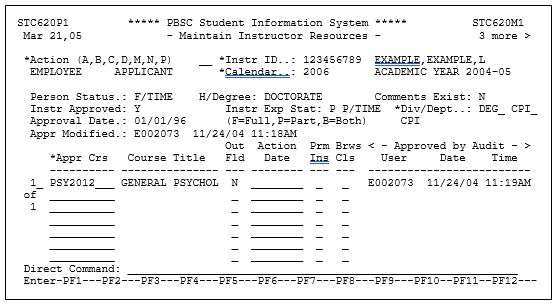
Step 2 – Assign Faculty Member to the Class
After ensuring that the faculty member has been credentialed for the class, they may be assigned to the class as outlined in Section C of this manual. After assigning a faculty member to a class, you may proceed with the steps to produce a “pending assignment”, or you may choose to create the pending assignment at a later date when you are sure that the class is not in danger of being canceled. You may look at this as being completed in the same time frame as was currently used to confirm and report full-time faculty load and PAF forms for adjunct faculty.
Figure 2 – Assigning a Faculty Member to a Class
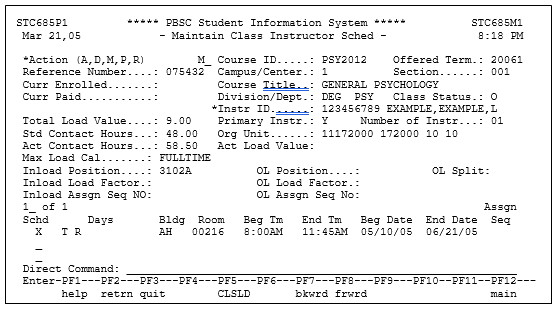
Step 3 - Determine the faculty load – is the class in-load or overload?
The faculty bargaining unit agreement specifies that each faculty member must teach 90 points during the contract period of fall and spring term. Teaching 90 points means not only classroom teaching, but “release” points that a faculty member is credited with for activities such as department chair, curriculum development or other approved activities. The faculty member’s supervisor may have approved that the faculty member teach 36 points (4 classes) in one term and 54 points (6 classes) in the next term which would fulfill the contract. The point is that the two terms combined (fall and spring) must equal 90 points:
Faculty Load Assessment – Full Load is 90 points

Instructor Reassignments
Some full-time faculty teach classes beyond their normal load, or they choose extra assignments such as department chair or developing a new course. In assessing faculty load for the year, if a faculty member is to earn over 90 points between the two terms, these points are termed “overload” points or ABOVEFUL. These points must be differentiated on the PantherNet system as they are paid differently than a faculty member’s regular rate of pay and are also paid on an additional assignment separate from their regular assignment.
To accurately determine and assign classes as in-load or overload, you must have all classes assigned to a full-time instructor on the system. The best approach is to process all the classes for one faculty member at a time. In the example below, you would consult with your associate dean on which class below would be the overload class. Please remember that if the faculty member is receiving any release time points (reassignments), these activities WILL NOT be shown on the screen below. Release time assignments are recorded under the screen labeled “reassignments.” The most important point here is that the associate dean is responsible for determining which of the classes are overload, based on their knowledge of the faculty member’s activities.
Example of an Instructor Class Schedule Screen
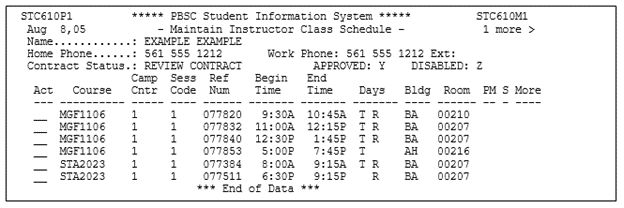
To access the Maintain Instructor Class Load Screen, you can use one of two methods:
- If you are still in the Maintain Class Instructor Screen (Figure 2) you may press the F5 key to access the Maintain Class Instructor Load screen (the key is labeled PF5-CLSLD).
- If you have already assigned the instructor and now you wish to create the pending assignment, use the following steps:
- Using the direct path CU CC MR, enter the reference number of the class and press Enter
- In the action field, choose M for modify
- Place a “Y” in the field labeled MORE next to the instructor’s name and press Enter
- Select the instructor using the “D” (display) key
- You should now be on the Maintain Class Instructor Screen – press F5 to access the Maintain Class Load Screen (the key is labeled PF5-CLSLD).
The following steps will illustrate creating the pending assignment for full-time faculty teaching an inload class in a fall or spring term:
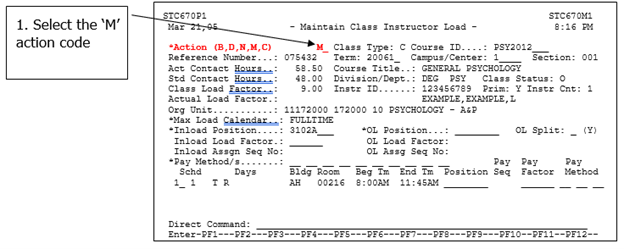
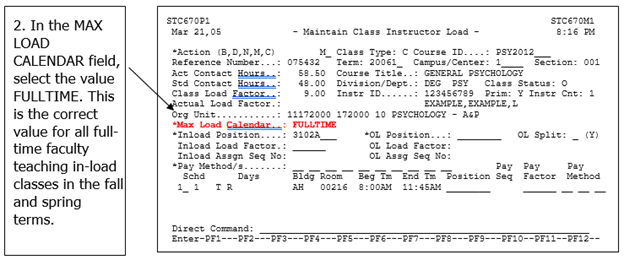
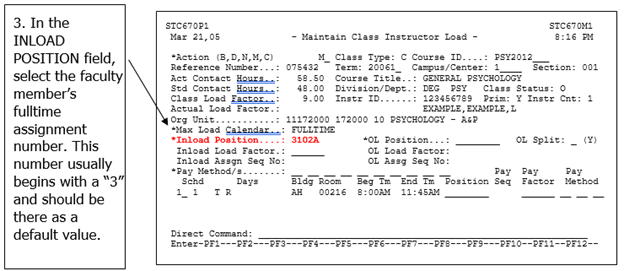
For a more detailed explanation of account numbers, GL codes and budget positions, please refer to Account Numbers in this manual.
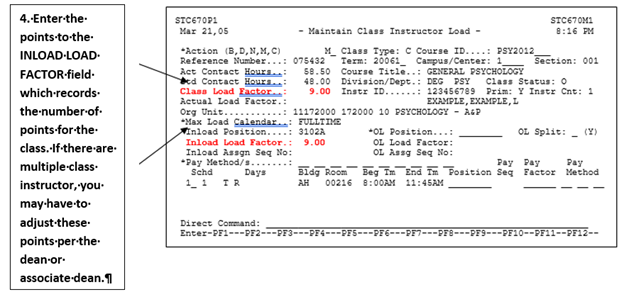
.ashx@h=252&w=624&la=en)
Please see Appendix G for a complete set of pay codes for faculty.
You have now completed the steps needed to process full-time faculty in the fall and spring classes for in-load classes.
The following steps will illustrate creating the pending assignment for full-time faculty teaching overload classes in a fall or spring term:
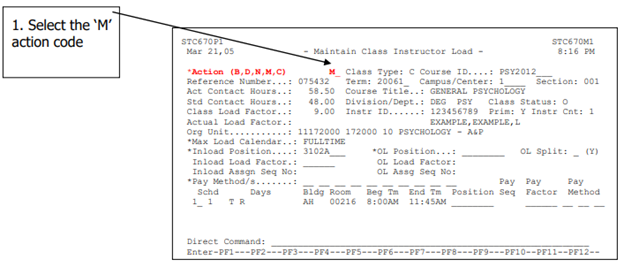
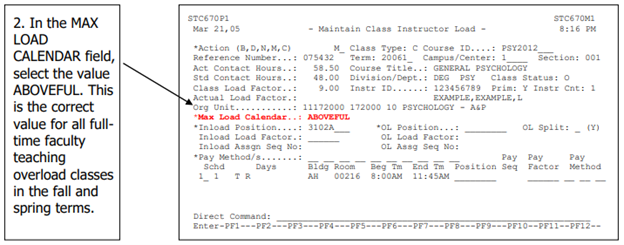

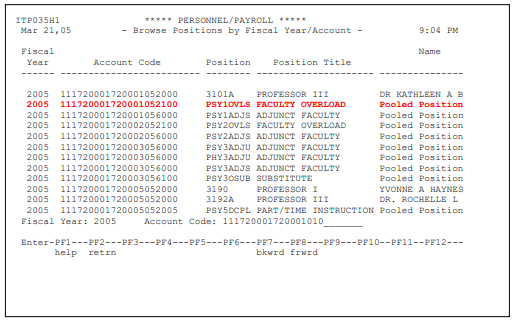
For a more detailed explanation of account numbers, GL codes and budget positions, please refer to Account Numbers in this manual.
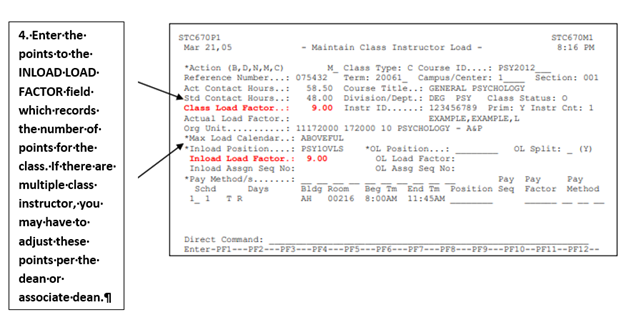
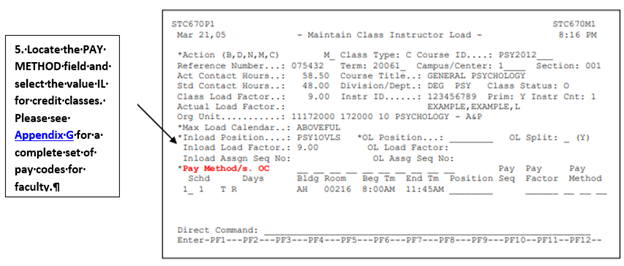
Please see Appendix G for a complete set of pay codes for faculty.
You have now completed the steps needed to process full-time faculty in the fall and spring classes for overload classes.
Some Important Points:
The highlighted fields below are currently not a part of the IRM system as it is programmed. All assignments (in-load and overload) must be captured on the fields labeled inload.
